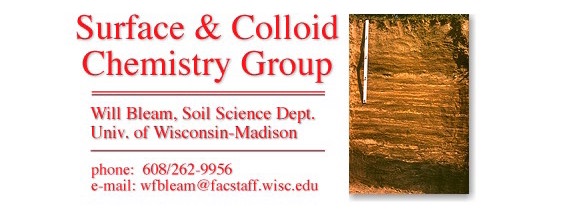 Soil Science 230
Soil Science 230
 Group Leader
Group Leader
 Students
Students
 Research
Research
 E-Mail
E-Mail
 Soil Science Home Page
Soil Science Home Page

Modified: 9/2/99
 Soil Science 230
Soil Science 230
 Group Leader
Group Leader
 Students
Students
 Research
Research
 E-Mail
E-Mail
 Soil Science Home Page
Soil Science Home Page
Providing opportunities for students, both graduate and undergraduate, is the central and most important function of the Soil Science Surface & Colloid Chemistry Program at the University of Wisconsin-Madison. We believe that excellence in research can be fully justified by a program that provides diverse, challenging and relevant research opportunities for students at all levels.
 Group Leader
Group Leader
 Students
Students
 Research
Research
 E-Mail
E-Mail
 Soil Science Home Page
Soil Science Home Page
The issues that interest us relate primarily to the fate and transport of compounds in soil environments. Examples include the binding of metals to humic substances, the sorption of pesticides and other organic compounds to humic substances and the chemical processes that influence the adsorption and distribution of inorganic ions at the mineral/water interface in soils. Our research is supported primarily by the U.S. Department of Agriculture National Research Initiative under the Soils and Soil Biology Program , but we work closely with representatives of the Wisconsin Department of Natural Resources to understand the contamination and remediation problems they face.
Our active programs involve the oxide/water interface of oxide and clay mineral and the colloidal properties of humic substances. Ultimately our experimental program will span the surface and colloidal properties of all soil colloids.
Our approach draws heavily on physical methods, mainly magnetic resonance and x-ray absorption spectroscopies. We initiated a program at the National Synchrotron Light Source (NSLS) at Brookhaven National Laboratory in the fall of 1992. Our synchrotron studies include both XANES and EXAFS studies of metals bound to oxide surfaces and humic substances.
We conduct most of our nuclear magnetic resonance studies at the Nuclear Magnetic Resonance Facility At Madison (NMRFAM), which is supported by the National Science Foundation. Our synchrotron studies include both XANES and EXAFS studies of metals bound to oxide surfaces and humic substances. Our magnetic resonance studies are directed toward understanding pesticide binding to humic substances and the colloidal properties of aqueous humic micellar solutions.
 Group Leader
Group Leader
 Students
Students
 Research
Research
 E-Mail
E-Mail
 Soil Science Home Page
Soil Science Home Page
To send e-mail messages:
 wfbleam@facstaff.wisc.edu
wfbleam@facstaff.wisc.edu